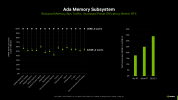This sounds like a language barrier to me. DegustatoR, "It doesn't say anything" doesn't mean "It's not the main factor". It means "has no impact whatsoever, directly or indirectly, on the matter". I think it's obvious that die size isn't the only thing, or even the main thing, affecting the final price of a graphics card and I think that's what you are trying to say. You can't possibly mean that there is no *indirect* connection between die size and pricing... no company would sell a $400 chip for $200, they'd just cancel the product.
When you say "[doesn't] correlate in any way to another chip made on a different process", the production cost is very roughly "die size * yields * wafer cost", so die size isn't enough to say anything without knowing the other factors, but there *is* a correlation to the cost. And similarly, the cost isn't the only factor or even the main factor affecting positioning in some cases, but it is *one* of the factors.
You know what they say... Only a Sith deals in absolutes!

EDIT: And obviously TSMC 4nm wafers are more expensive now than TSMC 12nm wafers, even if you look at their relative cost at the same point in the process lifetime. But some of what is making these GPUs bigger is larger caches that are allowing them to use cheaper memories, and DDR4/DDR5 prices have gone down a lot due to oversupply, so I suspect GDDR6 prices have gone down a bit too. Therefore, I'm not convinced the bill of materials has gone up as much as the wafer cost would imply, but interestingly if the larger L2 cache reduces the bill of material overall (so in terms of raw profits it's a win) but replaces "low margin DRAM" with "high margin GPU" then you'd expect the board price to go up rather than down for the same gross margins despite higher gross profits... this kind of thing is really complicated and it's good to avoid absolute statements unless you have a lot of insider knowledge.



